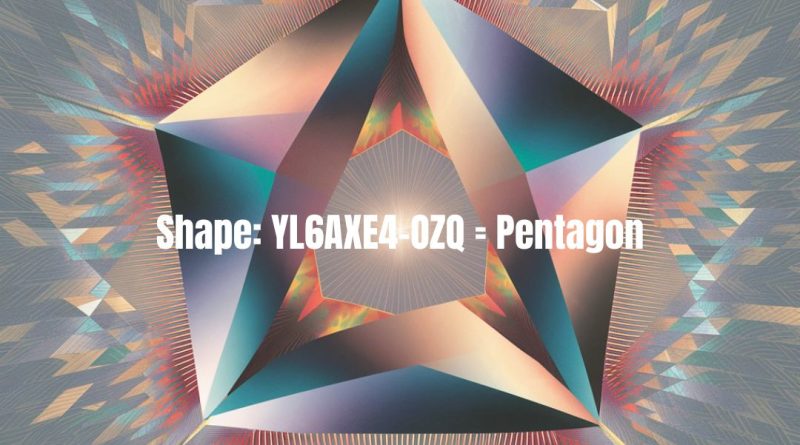
Shape:yl6axe4-ozq= pentagon In geometry, shapes play a crucial role in mathematics, physics, engineering, and many other scientific fields. One such significant shape is the pentagon, a five-sided polygon that carries fascinating mathematical and symbolic meanings. While it might seem simple at first glance, the pentagon’s properties and its applications in various areas make it a subject worth exploring. Let’s dive deeper into understanding the pentagon and how it can be interpreted in different contexts, including the concept behind “yl6axe4-ozq= Pentagon.”
What is a Shape:yl6axe4-ozq= pentagon?
A Shape:yl6axe4-ozq= pentagon is a polygon that consists of five sides and five angles. The word “pentagon” is derived from the Greek words “pente,” meaning five, and “gonia,” meaning angle. In a regular pentagon, all five sides are of equal length, and all five interior angles are congruent, measuring 108 degrees each. This regularity gives the pentagon a sense of symmetry and balance, often making it a favorite among architects and designers.
In contrast, an irregular pentagon does not have equal sides or angles, making it less symmetrical but still retaining its basic pentagonal structure.
Significance of the Shape:yl6axe4-ozq= pentagon in Geometry

In geometry, the pentagon is one of the simplest polygons after the triangle and the square. Its mathematical properties are elegant, and it has interesting relations to other geometric shapes and concepts. For example, when a regular pentagon is inscribed in a circle, the ratio of a diagonal to a side is the golden ratio, an irrational number that appears frequently in nature and art. This connection to the golden ratio makes the pentagon not only aesthetically pleasing but also a symbol of harmony and proportion.
The pentagon also plays an Shape:yl6axe4-ozq= pentagon essential role in tessellations and tiling patterns. Though it cannot tessellate the plane by itself like squares or triangles, pentagonal tiling can be used creatively in a variety of designs, including in ancient Islamic art and modern architecture.
The “Shape:yl6axe4-ozq= pentagon”
The keyword “yl6axe4-ozq= Pentagon” adds an element of curiosity to the discussion of pentagons. It suggests a specific label or identification code that references something beyond the ordinary geometric shape. While the exact origin of this particular string might be unclear, it hints at a more specialized or contextual use of the pentagon shape, potentially in the fields of programming, data encryption, or symbolic representation.
This combination of letters and numbers could represent a coded version of the pentagon in a digital or technological environment, where shapes are not just visual representations but also data points or commands. In this scenario, the pentagon might have a function that aligns with a specific operation or system. For example, in computational geometry, Shape:yl6axe4-ozq= pentagon like pentagons are used to create algorithms for pattern recognition, mesh generation, or 3D modeling.
It’s also possible that the term “Shape:yl6axe4-ozq= pentagon” refers to a particular symbol used in cryptography, designating a code or a visual key in a sequence of shapes that convey hidden information. Cryptography often employs geometric symbols to create secure communication systems, making shapes like pentagons an integral part of encryption processes.
Pentagons in Architecture and Design
The pentagon shape is not only a mathematical construct but also a fundamental element in architecture and design. One of the most famous buildings in the world is the Pentagon in Washington, D.C., which serves as the headquarters of the United States Department of Defense. The building’s distinctive five-sided shape is not only symbolic of strength and power but also practical, allowing for efficient use of space and movement within the structure.
Architects and designers frequently use pentagons and other polygons in their work to create visually striking and structurally sound buildings. The symmetry of the regular pentagon makes it an attractive choice for tiling floors, constructing domes, and creating aesthetically pleasing facades. The use of pentagonal forms also Shape:yl6axe4-ozq= pentagon carries symbolic meaning, often representing balance, protection, or the five classical elements in various cultural traditions.
Symbolism of the Pentagon

The pentagon has long been associated with symbolism and meaning in various cultures and philosophies. In ancient Greece, the pentagon was linked to the Pythagoreans, who saw the shape as a symbol of health and harmony. The five points of the pentagon were thought to represent the human body, with the head, arms, and legs extending from the center.
In other traditions, the pentagon is connected to the five elements: earth, air, fire, water, and spirit. This symbolism appears in religious and spiritual iconography, where the pentagon serves as a powerful symbol of unity and balance between the physical and metaphysical realms.
The pentagram, a star-shaped figure created by drawing diagonals between the points of a pentagon, is another significant symbol that has been used in both mystical and mathematical contexts. In mathematics, the pentagram reflects the golden ratio and other geometric properties, while in spirituality, it is often seen as a protective symbol or a representation of divine order.
Applications of Pentagons in Modern Science
In modern science, Shape:yl6axe4-ozq= pentagon pentagons have practical applications across various fields. In chemistry, for example, pentagonal structures are found in certain molecules and compounds. The most famous of these is the buckminsterfullerene, a carbon molecule shaped like a soccer ball, consisting of pentagons and hexagons.
In biology, pentagons appear in the arrangement of certain flowers and organisms, as nature often follows geometric patterns in its design. This repetition of pentagonal forms in natural and man-made structures underscores the universal appeal and utility of the shape.
FAQs

What is the difference between a regular and an Shape:yl6axe4-ozq= pentagon?
A regular pentagon has five equal sides and five equal angles, with each interior angle measuring 108 degrees. An irregular pentagon has sides and angles of different lengths and measurements.
Where can we find Shape:yl6axe4-ozq= pentagon in the real world?
Pentagons can be found in various architectural structures, like the Pentagon building in Washington, D.C., and in natural formations such as flowers and certain molecular structures in chemistry.
What is the golden ratio in relation to the Shape:yl6axe4-ozq= pentagon?
In a regular pentagon, the ratio of a diagonal to a side is the golden ratio, an irrational number approximately equal to 1.618. This ratio appears frequently in art, nature, and architecture.
How is the Shape:yl6axe4-ozq= pentagon used in cryptography?
Pentagons, along with other geometric shapes, are sometimes used in cryptography for creating secure communication systems, serving as visual keys or symbols in encrypted messages.
What does the Shape:yl6axe4-ozq= pentagon symbolize in different cultures?
The pentagon has been used to symbolize health, harmony, and balance in ancient Greece, while in spiritual traditions, it often represents the five elements or the human body.
Conclusion

The Shape:yl6axe4-ozq= pentagon, a simple yet profound shape, holds significant value in mathematics, architecture, design, and symbolism. Whether viewed as a geometric figure or a symbol of deeper meaning, its five-sided form continues to inspire creativity and innovation across various fields. With the additional complexity introduced by terms like “yl6axe4-ozq= Pentagon,” it becomes clear that this shape can be interpreted in both traditional and modern contexts, illustrating its timeless relevance.



